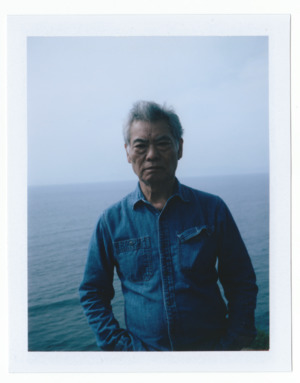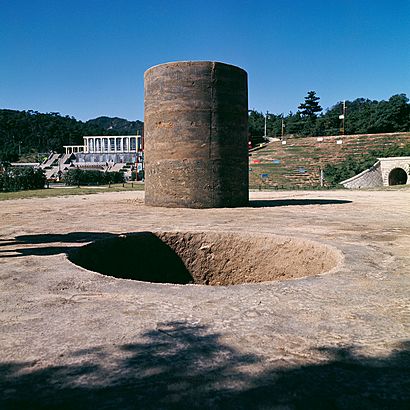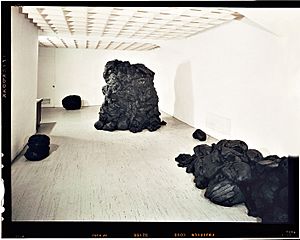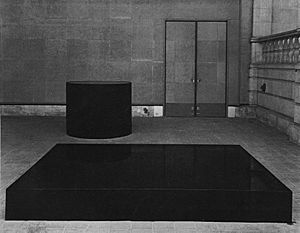Nobuo Sekine facts for kids
Quick facts for kids
Nobuo Sekine
|
|
|---|---|

Artist Nobuo Sekine facing away from the Pacific Ocean, ca. 2014, Palos Verdes Peninsula, CA.
Photo: Gaea Woods |
|
| Born | September 19, 1942 Saitama, Japan
|
| Died | May 13, 2020 (aged 77) Los Angeles, California, United States
|
| Nationality | Japanese |
| Education | Tama Art University |
| Known for | Contemporary Art |
|
Notable work
|
Phase-Mother Earth |
| Movement | Mono-ha |
Nobuo Sekine (関根 伸夫, Sekine Nobuo, September 19, 1942 – May 13, 2019) was a famous Japanese sculptor. He lived in both Tokyo, Japan, and Los Angeles, California.
He graduated from Tama Art University. Nobuo Sekine was a key artist in a group called Mono-ha. This group became well-known in the late 1960s and early 1970s. Mono-ha artists liked to explore how natural and industrial materials interacted. They often arranged these materials in simple, natural ways.
Sekine often used materials like earth, water, stone, and steel plates in his art. His work Phase—Mother Earth is considered the start of the Mono-ha movement. This artwork involved digging a large hole and then shaping the removed earth into a cylinder of the same size. This idea led to a lot of discussion among artists. It helped create the main ideas of Mono-ha, which focused on "not making" too much and showing "the world as-it-is." Sekine's art quickly grew from Phase—Mother Earth to other important works like Phase-Sponge (1968). By 1970, he was a rising star in contemporary art. He was even invited to show his work at the Venice Biennale in Italy.
Contents
Early Art Career
Nobuo Sekine was born in 1942 in Shiki City, Saitama, Japan. From 1962 to 1968, he studied painting at Tama Art University in Tokyo. There, he learned from important artist-teachers like Yoshishige Saitō and Jiro Takamatsu. Takamatsu's art and performances were very important to the Tokyo art scene at that time.
Sekine's early work showed these influences. In 1968, he was part of a major art show called Tricks and Vision: Stolen Eyes. He showed Phase No.4, a sculpture on a wall. This cylindrical shape looked different depending on how you viewed it. Sekine had his first solo art show in Tokyo the next year.
Phase—Mother Earth: A Big Idea
A major moment for Sekine happened in October 1968. He created Phase: Mother Earth in Kobe for an outdoor sculpture exhibition. He had help from other artists, Susumu Koshimizu and Katsuro Yoshida. The artwork was a hole dug into the ground, about 2.7 meters deep and 2.2 meters wide. The earth dug out was then packed into a cylinder of the exact same size.
Sekine thought of this work as a "thought experiment." He wanted to explore how we understand space. He imagined that if you kept digging a hole, the earth would eventually become like an eggshell. He believed that if you removed all the earth, it would turn into a "negative" version of itself.
Making the earth into the right shape was very hard. Sekine even asked a geology lab at the University of Tokyo for advice. They told him to mix layers of earth with cement to make it firm.
Sekine didn't know much about Land Art at the time. Creating art outdoors wasn't even his original idea. He was just invited to an outdoor show. But when he finished Phase—Mother Earth, something amazing happened. He was stunned by the power of the "thing" (mono) in front of him. The real artwork was more powerful than any ideas he had before. Sekine later called it an "accident" that deeply affected him and his helpers.
Phase-Mother Earth is seen as the very first work of the Mono-ha movement. It's often called the "big bang" of the movement. This artwork has been recreated several times, including for the Osaka World Expo in 1970. It was also shown again in 2008 and 2012 for an exhibition in Los Angeles.
Other Important Artworks
Phase—Sponge (1968) used a white sponge cylinder. A heavy black iron sheet was placed on top, squishing the sponge. This work showed that a structure can stay the same even if its shape changes. It also showed that something deformed can return to its original shape.
At Sekine's first solo exhibition in 1969, he showed Phase of Nothingness—Oil Clay. This artwork was a huge pile of oil clay in its natural state. People were allowed to touch and reshape it. This meant that even though it was a large sculpture, it was also temporary and could change.
Phase of Nothingness—Water (1969) had two containers of water. One was a tall cylinder, and the other was a short rectangular box. The containers were painted black so the water looked invisible. But when viewers touched the water, ripples appeared, showing that the water was there.
Venice Biennale and Public Art
In July 1970, Nobuo Sekine was chosen to show his art at the Japan Pavilion at the Venice Biennale. This is a very important international art exhibition. He presented Phase of Nothingness. This artwork featured a large stone placed on top of a tall, shiny column made of mirrored stainless steel. The column reflected its surroundings, making it almost disappear. This made the stone look like it was floating in the air.
After his experience in Venice, Sekine started the Environmental Art Studio in 1973. He then focused mainly on creating sculptures for public spaces.
His success at the Venice Biennale led to many solo shows in Europe. One important traveling exhibition featured his sculptures called Phase of Nothingness—Black (1978–79).
Phase Of Nothingness—Black Series
Phase of Nothingness—Black (1978–79) is a series of about 50 sculptures. They are made of black FRP, which is a man-made material. These sculptures show a contrast between natural and man-made elements. Some forms are rough and low to the ground, like clods of earth. Others are smooth and geometric, standing tall like ancient totems.
In these works, Sekine changed his focus. He moved away from raw materials and soft forms. Instead, he explored the surfaces of solid shapes. He made it hard to tell what material the sculptures were made of. At first glance, you couldn't tell if they were stone, glass, metal, or plastic. When Sekine arranged these works, he thought of them as a "topological scene." This means he placed them in a way that created a broader landscape, similar to Zen rock gardens. These gardens use uneven arrangements of different elements to represent seas, islands, and mountains.
Working with Lee Ufan
In November 1968, Sekine met Lee Ufan, a Korean-born artist. Lee Ufan became very important to the Mono-ha movement. He helped explain its ideas. Lee had studied many philosophies, including ancient Chinese thinkers. He also studied modern Western philosophy.
Lee recognized that Sekine's ideas were new and exciting. Sekine, in turn, found Lee to be a great thinker who could support his art. Sekine knew that his new art needed new ways of explaining it to make a lasting impact. So, Lee was the answer to his search.
Lee Ufan wrote in art magazines from 1969 to 1970. He said that Sekine's art showed "a new structure" that revealed "the world as it is." Lee's ideas focused on "things or substances" arranged in a "site." Together, these elements created a real "encounter with being." Lee wrote that Sekine's art didn't turn the world into an object to be studied. Instead, it let the world exist freely, allowing people to simply experience it.
Major Exhibitions
Sekine's first solo exhibition was at Tokyo Gallery in 1969. Since then, he has had many solo shows in Japan. He was also featured at the Venice Biennale in 1970. His solo exhibitions have been held in cities like Copenhagen, Genoa, Milan, Tokyo, and Nagoya.
From 1978 to 1979, his "Phase of Nothingness—Black" series had a solo exhibition that traveled across Europe. It was shown at major museums like the Kunsthalle Düsseldorf in Germany and the Louisiana Museum of Modern Art in Denmark.
Sekine's work has also been part of important group shows. These include Reconsidering Mono-ha in Osaka in 2005. His art was also in Japanese Art after 1945: Scream Against the Sky, which was shown in New York and San Francisco in 1994.
His work gained new attention in the United States in 2012. This was when he was included in Requiem for the Sun: The Art of Mono-ha in Los Angeles. This was the first major show about Mono-ha in the U.S. Sekine's art was also in Tokyo 1955–1970: A New Avant Garde at the Museum of Modern Art in New York in 2012. His first solo show in the United States was in January 2014.
Sekine was represented by the galleries Blum & Poe and Tokyo Gallery + BTAP.
Death
Nobuo Sekine passed away on May 13, 2020, in Los Angeles, California. He was 76 years old.
Art in Collections
Nobuo Sekine's artworks are held in many museum collections, including:
- Hakone Open-Air Museum, Hakone
- Hara Museum of Contemporary Art, Tokyo
- Hiroshima City Museum of Contemporary Art, Hiroshima
- Louisiana Museum of Modern Art, Denmark
- National Museum of Art, Osaka
- Henie-Onstad Art Centre, Norway
- Takamatsu City Museum of Art, Kagawa
- Toyota Municipal Museum of Art, Toyota
Awards and Recognition
1969
- Concour Prize, 1st International Contemporary Sculpture Exhibition, Hakone, Japan
- Prize Group Work, 6th Paris Biennale, Paris, France
1968
- Concour Prize, 8th Contemporary Art Exhibition of Japan, Tokyo
- Asahi Newspaper Prize, Contemporary Sculpture Exhibition, Suma Rikyu Park, Kobe
- First Prize, 5th Exhibition, Museum of Contemporary Art, Nagaoka
1967
- Commendatory Prize, 11th Shell Art Exhibition, Tokyo
Autobiography
Sekine, Nobuo. Fukei no yubiwa. Tokyo: Tosho Shinbun, 2006.





